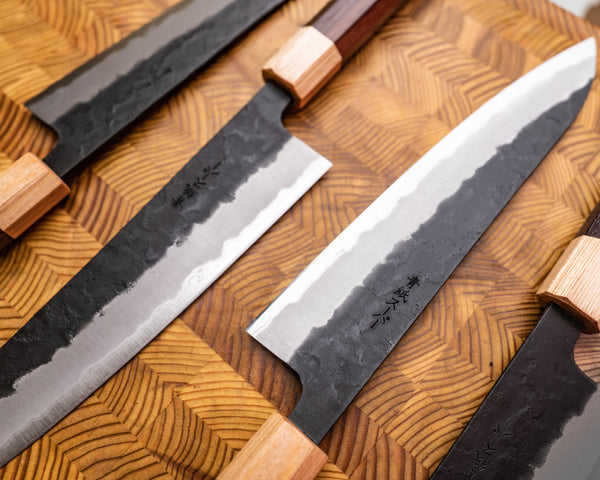How to Choose a Japanese Kitchen Knife
So you’re interested in getting a new knife? Awesome, New Knife Day is the best day! There’s a lot to choose from out there, so I'm here to make it easy for you. When you’re choosing a knife, there are three main things you should consider:
- What shape do you need?
- What kind of maintenance are you comfortable with?
- The wow factor - what kind of looks will get you excited to use it?
Do things the easy way. Take our knife quiz!
When starting your collection, it’s important to think about what you enjoy cooking and what you cook often. Most people really only need a great chef’s knife (gyuto), a veggie knife (nakiri), and a utility blade (petty). Here’s a few shapes you could get started with:

Fujimoto Hammer Tone 210mm Gyuto
Gyuto
The go-to knife in most kitchens around the globe, a gyuto can do almost anything, but it does have a bias towards larger food and meats. They range in length between 150mm all the way up to an impressive 360mm, with 210mm and 240mm being the most common lengths. If you’re minimally minded and only want one knife, get a gyuto! Learn more about Gyutos.

Petty
This is the Japanese name for a paring or utility knife. It’s perfect for hand peeling fruits and veggies, but is equally as handy on a cutting board for tasks that require greater articulation - trimming fat and silver skin off meat, or coring a mango come to mind. Petties can be as small as 75mm, and as large as 180mm, so there’s something to fit any hand, big or small.

Nakiri
The naikiri isn’t the most well known shape in the Western kitchen, but they are hands-down the best tool for the job they’re made for. With their flat edge they make chopping vegetables a breeze. The push chopping technique which the nakiri makes incredibly easy to do reduces those annoying accordion cuts. You know, when your onions are strung together like a string of paper dolls? Do yourself a favour and Google a solid French onion soup recipe and go to town with your nakiri. Learn more about nakiris.

Haruyuki Nishiki 165mm Santoku
Santoku
Santoku means “three virtues,” or “to solve three problems.” Basically, a knife that can do it all: slicing, dicing and mincing. If you can master these cuts, you can pretty much attack any recipe launched at you. The santoku starts flat at the heel, exceptional for cutting vegetables, and eventually curves upwards towards the tip, giving it more versatility for slightly finer work. Learn more about santokus.
You’ll know better than anyone what knife you need first, second, etc. so trust your gut but don’t be afraid to ask our opinion. We always have opinions, it’s what we’re here for!
Maintenance Level: Wait, Some Knives Can Rust?
Stainless steel is the industry standard for commercial knives in the west, but many traditional Japanese blacksmiths prefer the performance and tradition of more old-fashioned steels. Why would they want to use steel that can rust? Put simply, it's a joy to work with: it takes a truly incredible edge, and it changes colour over time as it builds a patina. To keep things simple, we can break knife steel into three categories:
- Low Maintenance. These knives will only ever rust if you really mis-treat them. You'll want to wash and dry them by hand, but there's no rush. These are generally labelled as 'stainless steel'.
- Some Maintenance. These require more care, but nothing nuts. Wash and dry your knife right when you're done chopping, and you won't have any issues. These tend to rust more slowly or just on the edge if mistreated, so they're pretty simple to maintain. Usually labelled at 'semi-stainless' or 'stainless-clad carbon steel'.
- High Maintenance. These will rust if you look at them wrong. Wipe your blade any time you set the knife down, and you'll be rewarded with a beautiful patina after several months. If they get a little rust it's no big deal, but if you're not down with fussing over your knife, skip these carbon steel blades.
Another thing to consider: some knives are made with harder steel than others. In general, Japanese steel is super hard, which is why it can hold such a sharp edge for such a long time. The harder steel gets, the more brittle it can get, so Japanese knives are generally terrible for cutting bones and other hard foods. Within the world of Japanese knives, there is a spectrum of hardness, ranging from somewhat hard to "holy bananas, that's hard!" The 'Rockwell scale' is a handy indicator of edge retention and likeliness of chipping. Japanese knives start around 58-60, which keep an edge well and don't chip super easily. They go as high is 65-66 and beyond, which are quite easy to chip but hold an edge for an extremely long time. Much like rusting, think about how careful you are with your tools, and choose accordingly.
Regardless of which knife you pick, we always recommend you abide by the golden rule: If you think it would hurt to bite it, don’t try to cut it! Kitchen knives are designed to slice up meat, veggies, fish, and other stuff for you to put in your mouth. They’re not hammers or screwdrivers. Always avoid cutting through bones, frozen food, pits and stems. That said, if you do chip your knife, we’ll always have your back! We sharpen and repair knives, and the first time on any knife from us is free.
If you want to learn more about choosing steel types, check out the Non-Nerd’s Guide to Knife Steels.
The Wow Factor
So far, we’ve just been talking facts. Shapes, rust, brittleness, you know, boring stuff. The fact of the matter is that knives can be works of art. That's probably what inspired you to grab one in the first place!

The Masakage Kumo, Koishi, and Shimo and Santokus.
See? There is no shortage of variety in terms of feel, balance, and overall aesthetic. These knives are art! They’re designed to evoke emotion, both when you look at them and when you cut with them. It’s no coincidence that the best selling knife here at the shop just so happens to be a STONE COLD FOX. At the end of the day, the knife that you're most excited about will be the one you use most in your kitchen.

The Haruyuki Shiso 210mm Gyuto, our best-selling knife.
This is all a lot to absorb, I know. But hopefully, you’ve got a little something to work with now. To boil it down:
- Start with a knife you'll use daily. A shape that feels comfortable and familiar is likely to be the most useful.
- Don’t be afraid to choose with your eyes. We've done a lot of hard work to carry what we consider to be some of the best knives on the planet. It’s perfectly OK to be picky-choosy based on how they look.
- Don’t buy anything you don’t want! If you don’t want a fussy carbon steel blade, don’t talk yourself into buying one. We have plenty of kickass stainless steel beauties, or even carbon steel knives with stainless cladding that can hold their edge just as well as their high-maintenance cousins.
From here, you can start your knife-choosing journey, or check out more relevant reading below. Happy new knife day!





